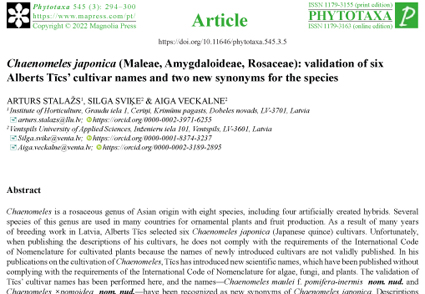Abstract
Chaenomeles is a rosaceous genus of Asian origin with eight species, including four artificially created hybrids. Several species of this genus are used in many countries for ornamental plants and fruit production. As a result of many years of breeding work in Latvia, Alberts Tīcs selected six Chaenomeles japonica (Japanese quince) cultivars. Unfortunately, when publishing the descriptions of his cultivars, he does not comply with the requirements of the International Code of Nomenclature for cultivated plants because the names of newly introduced cultivars are not validly published. In his publications on the cultivation of Chaenomeles, Tīcs has introduced new scientific names, which have been published without complying with the requirements of the International Code of Nomenclature for algae, fungi, and plants. The validation of Tīcs’ cultivar names has been performed here, and the names—Chaenomeles maulei f. pomifera-inermis nom. nud. and Chaenomeles ×pomoidea nom. nud.—have been recognized as new synonyms of Chaenomeles japonica. Descriptions have been provided for all Alberts Tīcs’ cultivars.
References
<p>Bartish, I.V., Garkava, L.P., Rumpunen, K. & Nybom, H. (2000) Phylogenetic relationships and differentiation among and within populations of <em>Chaenomeles</em> Lindl. (Rosaceae) estimated with RAPDs and isozymes. <em>Theoretical and Applied Genetics</em> 101: 554–563. https://doi.org/10.1007/s001220051515</p>
<p>Bartish, I.V., Rumpunen, K. & Nybom, H. (2000) Combined analysis of RAPDs, cpDNA and morphology demonstrate spontaneous hybridization in the plant genus <em>Chaenomeles</em>. <em>Heredity</em> 85: 383–392. https://doi.org/10.1046/j.1365-2540.2000.00773.x</p>
<p>Beissner, L., Schelle, E. & Zabel, H. (1903) <em>Handbuch der Laubholz-Benennung: systematische und alphabetische Liste aller in Deutschland ohne oder unter leichtem Schutz im freien Lande ausdauernen Laubholzarten und Formen mit ihren Synonymen, </em>Volume 6. Parey, Berlin, 625 pp.</p>
<p>Brickell, C.D., Alexander, C., Cubey, J.J., David, J.C., Hoffman, M.H.A., Leslie, A.C., Malécot, V. & Jin, X.B. (2016) International code of nomenclature for cultivated plants (ICNCP or Cultivated Plant Code), ninth edition. <em>Scripta Horticulturae</em> 18: 1–190.</p>
<p>Burmistrov, A.D., Anger, F.P. & Riesktiņš, J.P. (1956) Ajva yaponskaya nizkaya I ee ispol’zovanie. <em>Latvijas Lauksaimniecības Akadēmijas Raksti</em> 5: 57–63.</p>
<p>Dimza, I. & Vēbers, K. (1990) No ērkšķaina dekoratīvā krūma līdz jaunai augļaugu kultūrai. <em>In</em>: Pūka, T. (Chief. ed.) <em>Tautsaimniecībā derīgo augu bioķīmija un bioloģija</em>. Rīga, pp. 38–42.</p>
<p>Frahm, G. (1898) <em>Cydonia maulei</em> Lavall. und <em>Cydonia maulei</em> var. <em>superba</em>. <em>Die Gartenwelt</em> 2: 214–215.</p>
<p>Galenieks, P. (1957) <em>Chaenomeles</em> Lindl. <em>In</em>: Galenieks, P. (ed.) <em>Latvijas PSR flora</em>, <em>3. sējums</em>. Latvijas Valsts izdevniecība, Rīga, pp. 53–54.</p>
<p>Hemsley, W.B. (1900) <em>Cydonia cathayensis</em>, Hemsl. <em>In:</em> <em>Hooker’s Icones Plantarum; or, figures, with descriptive characters and remarks, of new and rare plants selected from the Kew Herbarium</em>, 4<sup>th</sup> series, Vol. 7, part. III: 8.</p>
<p>Lindley, J. (1821) Observations on the natural group of plants called Pomaceae. <em>The Transactions of the Linnean Society of London </em>13: 88–106. https://doi.org/10.1111/j.1095-8339.1821.tb00058.x</p>
<p>M[asters], T.M. (1874) <em>Pyrus maulei</em>. <em>Gardeners’ Chronicle</em>, new series, 1: 756.</p>
<p>Nakai, T. (1929) <em>Choenomeles</em> in Japan. <em>Japanese Journal of Botany</em> 4: 327–334.</p>
<p>Rehder, A. (1920) New species, varieties and combinations from the herbarium and the collections of the Arnold Arboretum. Rosaceae (continued). <em>Journal of the Arnold Arboretum </em>2: 42–64.</p>
<p>Rumpunen, K., Bartish, I., Garkava-Gustavsson, L. & Nybom, H. (2003) Molecular and morphological diversity in the plant genus <em>Chaenomeles. In</em>: Rumpunen, K. (Ed.) <em>Japanese quince</em>—<em>potential fruit crop for northern Europe. </em>Swedish University of Agricultural Sciences, Department of Crop Science, Balsgård, pp. 1–13.</p>
<p>Schneider, C.K. (1906) <em>Illustriertes Handbuch der Laubholzkunde, Band 1.</em> Verlag von Gustav Fischer, Jena, 810 pp.</p>
<p>Spach, É. (1834) <em>Histoire naturelle végétaux. Phanérogames, Volume 10</em>. Librairie encyclopédique de Roret, Paris, 540 pp. https://doi.org/10.5962/bhl.title.44839</p>
<p>Sweet, R. (1818) <em>Hortus suburbanus Londinensis: or, A catalogue of plants cultivated in the neighbourhood of London, arranged according to the Linnean system</em>. James Ridgway, London, 242 pp. https://doi.org/10.5962/bhl.title.109914</p>
<p>Thunberg, C.P. (1780) Kaempferus illustratus seu Explicatio illarum plantarum, quas Kaempferus in Iaponia collegit et in fasciculo quinto Amoenitatum exoticarum adnotavit, secundum Systema sexuale ad Classes, Ordines, Genera et Species iam redactarum. <em>Nova Acta Regiae Societatis Scientiarum Vpsaliensis</em> 3: 196–209.</p>
<p>Skrīvele, M. (1920) <em>Es mācos augļkop</em>ī<em>bu</em>. Latvijas Mediji, Rîga, 415 pp.</p>
<p>Tīcs, A. (1959) <em>Zemā Japānas cidonija</em>. Latvijas Valsts izdevniecība, Rīga, 79 pp.</p>
<p>Tīcs, A. (1992) Krūmcidonijas, Avots, Rīga 111 pp.</p>
<p>Tīcs, A. (2000) <em>Ziemeļu citrons Cido</em>. <em>Jauna</em> <em>augļu kultūra</em>. [author’s edition], [Pūre], 257 pp.</p>
<p>Tiits, A. (1989) <em>Põõsasküdoonia</em>. Valgus, Tallinn, 223 pp.</p>
<p>Turland, N.J., Wiersema, J.H., Barrie, F.R., Greuter, W., Hawksworth, D.L., Herendeen, P.S., Knapp, S., Kusber, W.-H., Li, D.-Z., Marhold, K., May, T.W., McNeill, J., Monro, A.M., Prado, J., Price, M.J. & Smith, G.F. (eds.) (2018) International Code of Nomenclature for algae, fungi, and plants (Shenzhen Code) adopted by the Nineteenth International Botanical Congress Shenzhen, China, July 2017. <em>Regnum Vegetabile</em> 159. https://doi.org/10.12705/Code.2018</p>
<p>Weber, C. (1963) Cultivars in the genus <em>Chaenomeles</em>. <em>Arnoldia</em> 23: 17–75.</p>
<p>Weber, C. (1964) The genus <em>Chaenomeles</em> (Rosaceae). <em>Journal of the Arnold Arboretum</em> 45: 302–345. https://doi.org/10.5962/p.324684</p>
<p>Yü, T.T. & Kuan, K.C. (1963) Taxa nova rosacearum Sinicarum (I). <em>Acta Phytotaxonomica Sinica</em> 8: 202–234.</p>


